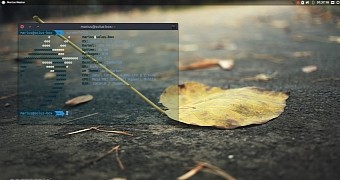Those of us living in the Solus world know that its development team grows each day faster than that of other Linux-based operating systems, and magic happens all the time for the rolling distro.
If you haven't used Solus until today, you should. It always gets the latest software releases and Linux kernel, and we're already using it as our primary OS. Its Budgie desktop environment is relatively slick, customizable, and shiny looking. For example, it can be quickly transformed into a piece of art, just look at the screenshot attached if you don't believe us, or check out what the guys over at the Ubuntu Budgie Remix (budgie-remix) have managed to accomplish.
However, it appears that some of the Solus engineers are hard at work these days to bring the Budgie desktop environment to a whole new level of slickness and customization. If you've been reading the news lately, maybe you know that a couple of days ago Solus developer and communications manager Joshua Strobl published yet another installation of the project's This Week In Solus (TWiS) newsletter, where he talked about the upcoming Budgie 11.0.0 release.
While the version number suggests a major update, Budgie 11.0.0 will, in fact, be the biggest ever release of the desktop environment used by default in Solus. Hearing that, we've immediately contacted project leader Ikey Doherty to tell us all about his plans for Budgie 11.0.0, which drops its monolithic architecture for a modular design, meaning that it will be split into multiple, smaller components that can be easily patched when needed and will significantly reduce the dependency on the GNOME Stack.
"This ensures a proper dependency model between the components, allowing individual components to run without the full Budgie Desktop present," said Ikey Doherty exclusively for Softpedia. "As an example, budgie-run-dialog and budgie-polkit-dialog, will rely on budgie-core for the global Budgie settings schemas and theming. They will not depend on budgie-panel, allowing the components to be freely used outside of Budgie."
Budgie moves to semantic versioning, will be written mostly in C
The new components of the upcoming Budgie 11.0.0 desktop environment are budgie-core, the package on which all the other Budgie components will depend, budgie-panel, which takes care of the panel you see on top of the screen, budgie-wm as the window manager, budgie-run-dialog as the application launcher dialog you'll run using the ALT+F2 keyboard shortcut, budgie-daemon for session support services, and budgie-polkit-dialog as the PolicyKit agent UI.
A budgie-session component is in the works as we speak, and with this change, the project is moving to semantic versioning with a versioned ABI, as part of the budgie-plugin C library. More code is converted back to C from Vala, and a fully C11-compliant capable compiler will be required for building Budgie 11.0.0. All these are technical details for those who want to deploy Budgie on their distros, but end-users should know that this major change ensures support for the GNOME apps.
Right now, the current Budgie version is stuck on the GNOME 3.20 Stack because of a flawed design decision to integrate it with GNOME itself instead of enabling GNOME apps to integrate with Budgie. Budgie 11.0.0 will change that, leading to a lighter and more streamlined Budgie desktop. The re-architecting of the Budgie desktop environment can be witnessed on its new home on GitHub at https://github.com/budgie-desktop. When will Budgie 11.0.0 be released? Sooner than you think!

 14 DAY TRIAL //
14 DAY TRIAL //